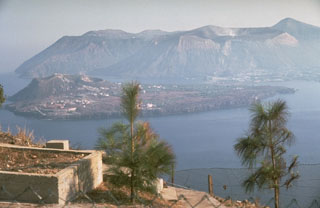Report on Vulcano (Italy) — October 1999
Bulletin of the Global Volcanism Network, vol. 24, no. 10 (October 1999)
Managing Editor: Richard Wunderman.
Vulcano (Italy) H2S, SO2, HF, HCl, and other gases tending to increase during 1998-99
Please cite this report as:
Global Volcanism Program, 1999. Report on Vulcano (Italy) (Wunderman, R., ed.). Bulletin of the Global Volcanism Network, 24:10. Smithsonian Institution. https://doi.org/10.5479/si.GVP.BGVN199910-211050
Vulcano
Italy
38.404°N, 14.962°E; summit elev. 500 m
All times are local (unless otherwise noted)
Periodic inspections of Vulcano have indicated that the total output from the fumarolic field at the crater "La Fossa" started to decrease in 1995. However, an analysis of the chemical compositions of the gaseous phases conducted as a part of an overall evaluation of the volcanic system provides important volcanological details. Different trends observed between the fumaroles located on the rim and those inside the crater (see BGVN 22:11) indicate that the Fossa cone is affected by deformation, possibly the result of increased vapor pressure at depth. The chemical data from samples collected at the same locations during 1998 and 1999 (table 6) indicate similar trends of increasing magmatic gases. This could imply widespread opening of the system, which could affect the stability of the edifice.
Table 6. Chemical data measured at Vulcano, 1998-99. Courtesy of Marino Martini.
| Component | Crater Rim 1997 | Crater Rim 1998 | Crater Rim 1999 | Inside Crater 1997 | Inside Crater 1998 | Inside Crater 1999 |
| Temperature | 328°C | 320°C | 303°C | 426°C | 281°C | 379°C |
| H2O (vol) | 88.86 | 90.77 | 93.66 | 85.38 | 86.69 | 91.65 |
| CO2 (dry) | 92.37 | 90.57 | 86.91 | 97.13 | 96.54 | 91.95 |
| H2S | 3.10 | 3.41 | 6.54 | 0.40 | 0.26 | 1.25 |
| SO2 | 2.11 | 2.30 | 2.78 | 0.99 | 1.55 | 3.90 |
| HCl | 1.26 | 1.47 | 1.77 | 0.78 | 0.43 | 0.85 |
| HF | 0.46 | 0.42 | 0.66 | 0.03 | 0.08 | 0.13 |
| H2 | 0.12 | 0.18 | 0.22 | 0.05 | 0.18 | 0.08 |
| CO | 0.0005 | 0.0006 | 0.0002 | 0.0024 | 0.0114 | 0.0100 |
In addition to the data reported in table 6, temperature measurements taken along the N rim of Fossa crater some time during the period 2-16 July 1999 were reported by Claude Grandpey. The temperature in July was 340°C compared to ~410°C the previous April. Grandpey also reported stable temperatures (i.e., 95-100°C) at the fumaroles on the isthmus between Vulcano and Vulcanello.
Vulcano is located at the southern boundary of the Aeolian Islands, about 25 km from northern Sicily. It last erupted in 1888-90 when numerous meter-sized bombs and blocks fell in the area now occupied by the village of Vulcano Porto, which hosts thousands of tourists daily during the summer season. Vulcanello, the youngest part of Vulcano Island, began to form only ~2,100 years ago as an isolated island that later became connected with the main island. The latest activity at Vulcanello occurred in the 16th century when lava flows, now covered by large hotel complexes, were extruded.
Geological Summary. The word volcano is derived from Vulcano stratovolcano in Italy's Aeolian Islands. Vulcano was constructed during six stages over the past 136,000 years. Two overlapping calderas, the 2.5-km-wide Caldera del Piano on the SE and the 4-km-wide Caldera della Fossa on the NW, were formed at about 100,000 and 24,000-15,000 years ago, respectively, and volcanism has migrated north over time. La Fossa cone, active throughout the Holocene and the location of most historical eruptions, occupies the 3-km-wide Caldera della Fossa at the NW end of the elongated 3 x 7 km island. The Vulcanello lava platform is a low, roughly circular peninsula on the northern tip of Vulcano that was formed as an island beginning more than 2,000 years ago and was connected to the main island in about 1550 CE. Vulcanello is capped by three pyroclastic cones and was active intermittently until the 16th century. Explosive activity took place at the Fossa cone from 1898 to 1900.
Information Contacts: Marino Martini, Dipartimento di Scienze della Terra, Università di Firenze, Via La Pira 4, 50125, Firenze, Italy; Claude Grandpey, L'Association Volcanologique Europénne (LAVE), 7 rue de la Guadelopue, 75018 Paris, France.

